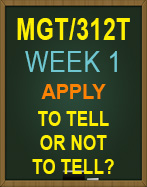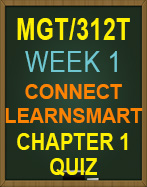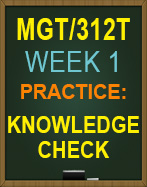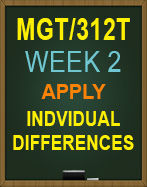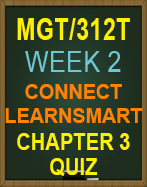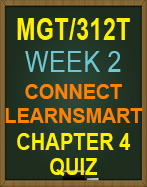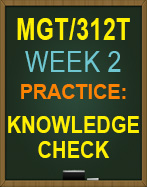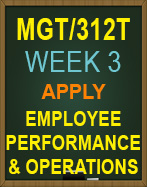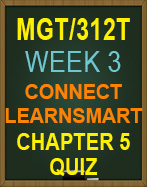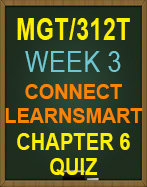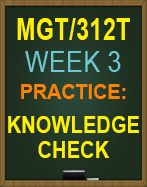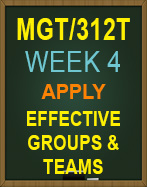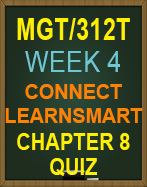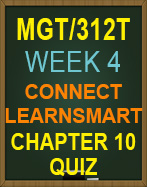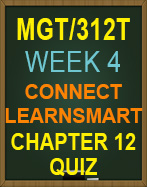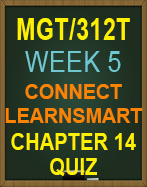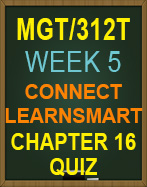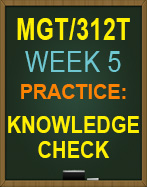MGT/312T Week 2
Everything listed for Week 2 is included in purchase!!
1. Practice: Connect LearnSmart Activity, Ch. 3
2. Practice: Connect LearnSmart Activity, Ch. 4
3. Practice: Week 2 Knowledge Check
4. Apply: Individual Differences
Practice: Connect LearnSmart Activity, Ch. 3
1. True or false. The percentage of non-Hispanic whites will grow in the US by 2060.
2. Which of the following statements regarding attribution theory are true?
3. When considering attribution theory, managers should remember that we tend to attribute behavior to ________ causes.
4. Heider’s attribution theory proposed that behavior can be attributed to either ______ factors, such as ability, or _______ factors, such as a difficult task.
5. Match the population size and event to the generations.
6. Match the years and defining invention to the generations.
7. Match the traits to the generations.
8. Match the dimension of attribution theory to the explanation.
9. Match the dimension of attribution theory to the explanation.
10. Recognition that the organization's markets and constituencies are culturally diverse is called a(n) ________-and -________ perspective on diversity.
11. Studies have shown that
12. Which of the following are true concerning perceptions in performance appraisals?
13. Kelley hypothesized that people make causal attributions by observing three dimensions of behavior: ___________, __________, and _____________.
14. Self-serving bias implies that people will credit successes to controllable __________ factors and failures to uncontrollable _____________ factors.
15. Affirmative action programs
16. One’s inclination to take more credit for success that for failure is called _____-______ bias.
17. People with disabilities
18. Which of the following are true concerning the experience of the LGBTQ workforce?
19. Which of the following statements about workplace challenges for LGBTQ people are true?
20. The number of race-based _______ cases deemed to have reasonable cause by US EEO commission more than doubled from 1995 to 2015. (one blank/one word)
21. Object recognition is a major function of _____________.
22. Select barriers to successful diversity programs at work.
23. Affirmative action programs have generated many opportunities for ______ and _______.
24. Characteristics that take awhile to emerge during interactions, such as attitudes, opinions and values, are called ________ characteristics. 25. Assigning someone’s behavior to his or her personal characteristics instead of the circumstances is called.
26. Implicit cognition results in
27. Select barriers to implementing successful diversity programs.
28. The fundamental _______ bias leads people to disregard environmental influences on behavior.
29. A cognitive process that enables people to interpret and understand their surroundings is called ___________.
30. Any thoughts or beliefs that are automatically activated from memory without our conscious awareness are examples of _____________.
31. Select the four layers of diversity.
32. Which of the following describe circumstances facing people with disabilities?
33. Programs to help people come back to their careers after taking a break are known as _________.
34. The ________/________ option in Thomas’ framework has the goal to either increase or decrease the number of diverse people at all levels of the firm.
35. The ________ option in Thomas’ framework is based on the action of moving the diverse person off to the side.
36. The _____________ option in Thomas’ framework is based on the belief that good relationships can rise above differences.
37. The __________ option in Thomas’s framework means people refute that differences exist.
38. The __________ option in Thomas’ framework means people are willing to adapt or change their views for the sake of creating positive relationships.
39. The ________ option in Thomas’ framework involves acknowledging differences but not valuing or accepting them.
40. The ________ option in Thomas’ framework means that differences are squelched or discouraged.
41. Managers should remember that ______ biases may lead managers to misinterpret employee behavior and take inappropriate actions.
42. Which of the following are true considering managerial implications of attributional tendencies?
43. Select barriers to implementing successful diversity programs.
44. The statistical measurements of populations and their qualities, such as age, gender, race, and income over time are:
45. Rank the four steps in stereotyping process with the first step at the top.
Practice: Connect LearnSmart Activity, Ch. 4
1. Diversity applies to:
2. Match the years and defining invention to the generations.
3. Which of the following are true concerning implicit cognition?
4. The statistical measurements of populations and their qualities such as age, gender, race, and income over time are _____________.
5. Rank the four steps in the stereotyping process with the first step at the top.
6. Which of the following are true concerning implicit cognition?
7. Select barriers to implementing successful diversity programs
8. Affirmative action programs have generated many opportunities for _____ and ________.
9. A cognitive process that enables us to Interpret and understand our surroundings is called:
10. The ___________ is an unseen barrier that stops women from advancing to higher-level positions.
11. An individual’s set of beliefts about the characteristics and attributes of a group is called a:
12. Match the term to the correct definition.
13. Select barriers to successful diversity programs at work.
14. One’s inclination to take more credit for success than for failure is called _____-______ bias.
15. Select predicted changes in diversity in the United States between 2020 and 2060.
16. Assigning someone’s behavior to his or her personal characteristics instead of the circumstances is called:
17. Match the dimension of attribution theory to the explanation.
18. Studies show that women have a harder time being perceived as effective leaders, which is a result of a negative __________.
19. Studies have shown that
20. Recognition that the organization’s markets and constituencies are culturally diverse is called a(n) _____-and-_______ perspective on diversity.
21. When someone has a job that takes less education than they have, it is called __________.
22. Gardenswartz and Rowe identified layers of _________ to help distinguish the important ways in which people differ.
23. True or false: The diversity climate is not very important within a firm.
24. Adopting policies and procedures that meet the needs of all employees encourages more _______ in organizations.
25. Characteristics of the perceiver include
26. Kelley hypothesized that people make causal attributions by observing three dimensions of behavior: _________, __________, and __________.
27. Managers can reduce the effect of stereotypes by
28. Which of the following statements about workplace challenges for LGBTQ people are true?
29. Examples of external influences of diversity are:
30. Generational differences in the workforce
31. The number of race-based ____________ cases deemed to have reasonable cause by US EEO commission more than doubled from 1995 to 2015. (one blank/one word).
32. Self-serving bias implies that people will credit successes to controllable ________ factors and failures to uncontrollable ________ factors.
33. Employees’ evaluations of leader effectiveness are strongly influenced by their __________ knowledge of what constitutes good and poor leadership.
34. __________ dimensions of diversity represent differences that we have a greater ability to influence or control.
35. An intervention intended to give management an opportunity to correct past imbalance, injustice, mistake, or outright discrimination is called
36. Which of the following are true concerning perceptions in performance appraisals?
37. Which of the following describe circumstances facing people with disabilities?
38. Causal attributions refer to
39. Select the components or strategies for successful diversity training in organizations.
40. Select improvements made in women’s equality by 2018.
41. Organizational behavior emphasizes ______ perception rather than object perception.
42. Managing diversity and targeting specific demographics
43. People with disabilities
44. The _______ option in Thomas’ framework means people are willing to adapt or change their views for the sake of creating positive relationships.
45. Select ways firms can retain an aging workforce.
46. The _______ option in Thomas’ framework is based on the action of moving the diverse person off to the side.
47. Managers should remember that attribution biases may lead managers to misinterpret employee behavior and take inappropriate actions.
48. The _______ option in Thomas’ framework means that differences are squelched or discouraged.
49. The _____ ________ option in Thomas’ framework is based on the belief that good relationships can rise above differences.
50. The idea that older workers are less motivated is a
51. The _______/_______ option in Thomas’ framework has the goal to either increase or decrease the number of diverse people at all levels of the firm.
52. The _____ option in Thomas’ framework involves acknowledging differences but not valuing or accepting them.
53. Programs to help people come back to their careers after taking a break are known as
54. Select the four layers of diversity
55. Which of the following are true considering managerial implications of attributional tendencies?
56. The _____ option in Thomas’ framework is based on the premise that eventually all people will learn to blend in or become like the dominant group
57. The ______ option in Thomas’ framework means people refute that differences exist.
58. When considering attribution theory, managers should remember that we tend to attribute behavior to ______ causes.
Practice: Week 2 Knowledge Check
1. True or False. It is always a mistake to use stereotypes.
2. True or False. Perception is influenced by three key components: the characteristics of the perceiver, of the target, and of the situation.
3. True or False. Managers can have a great impact on fixed individual differences.
4. True or False. Prejudice is one of the most common barriers to implementing successful diversity programs.
5. True or False. “Individual differences” is a narrow category only used to describe the “Big Five” personality attributes.
6. True or False. Self-esteem is a broad personality trait composed of self-efficacy, locus of control, and emotional stability.
7. A person who ________ is relatively unconstrained by situational forces and effects environmental change.
8. True or False. Diversity refers to age, gender, and religion, but does not include personality.
9. True or False. In the self-serving bias, employees attribute their success to internal factors and their failures to external factors.
10. Perception is the process of becoming consciously aware of something or someone.
11. The internal dimensions of diversity
12. True or False. In the self-serving bias, employees attribute their success to internal factors and their failures to external factors.
13. True or False. Intelligence cannot be modified or altered.
14. True or False. The potential to learn and use spoken and written languages is known as
linguistic intelligence.
15. Which of the following is not one of the basic dimensions of the Big Five
personality dimensions?
Apply: Individual Differences
1. According to Eagly and Carli, and also supported by subsequent data analysis by the textbook authors, women have broken through the glass ceiling. Based on what you have read in the case, which of the following trends in gender diversity appears to be most supported by the outcomes of LeasePlan's program changes?
2. Which of Thomas's generic action options for managing diversity is most illustrated in the case?
3. Which type of stereotype is described in the beginning of the video?
4. Todd Mcfarlane and others highlighted Todd's business skills, his artistic abilities, and his success in various types of media. Which of the dimensions of behavior from Kelley's Model of Attribution is reflected here?
5. Based on the information in the case, which of the following barriers and challenges to managing diversity that were identified in the text appear to have been present at Lease Plan?
6. Clearly Todd McFarlane has achieved a great deal of success both personally and in his company. However, it is also possible that he attributes all of his good fortune to his own efforts while placing the blame for any bad fortune on others. If this is accurate, then this would be an example of
7. A banker who has done several deals with Todd McFarlane and the McFarlane Company and knew that the company tends to be fiscally conservative would be less likely to stereotype Todd McFarlane as a risky, artistic type. Which perceiver characteristic best explains this outcome?
8. What is the main problem here for technology companies?
9. Which of the following is NOT a cause of workforce composition issues at technology companies?
10. What can be a strong reason that top universities graduate black and Hispanic computer science and computer engineering students at twice the rate that leading technology companies hire them?
11. If technology companies attempt to implement an affirmative-action type of diversity program, in order to solve the problem, which of the following would probably NOT result?
|


